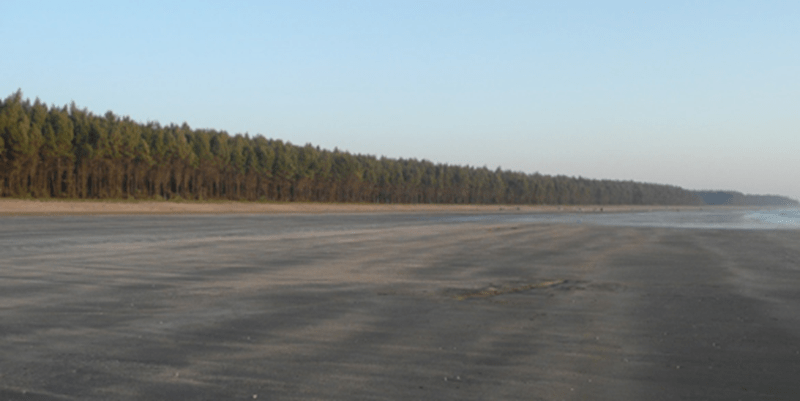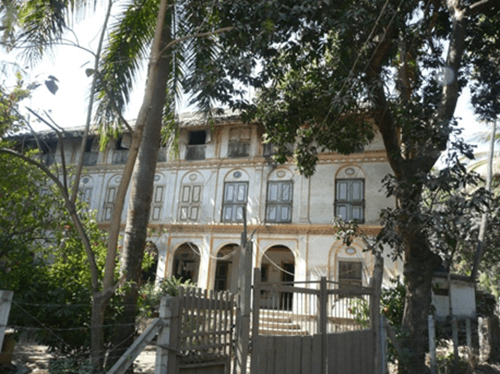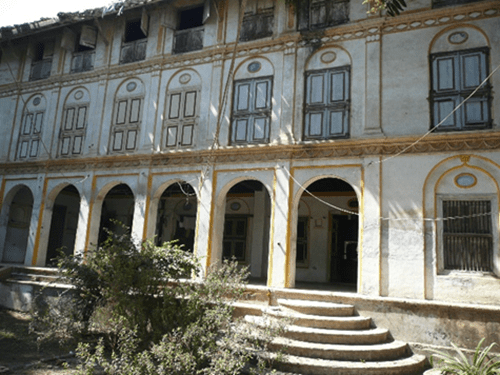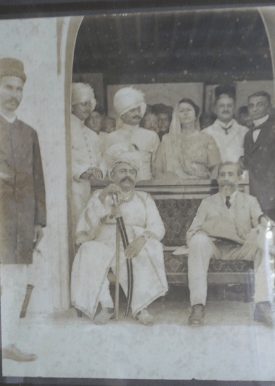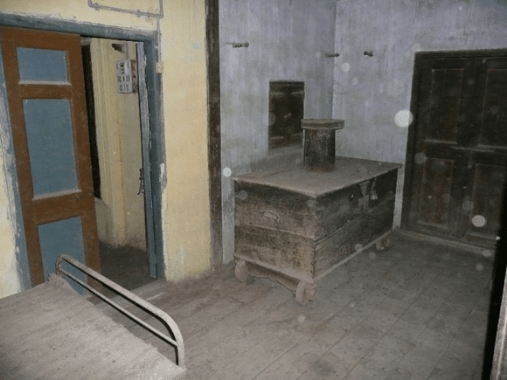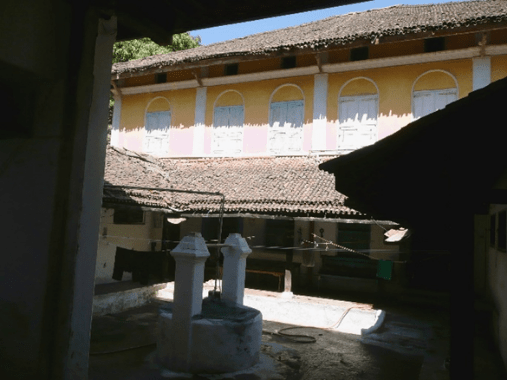Going back to the roots: an emotion in motion
A forgotten link of Govadia heritage
Article by Adil J. Govadia
Our large 3-tiered family haveli (bungalow), built way back in 1887, is located in a small Gujarat hamlet named Nargol, located on the southern tip of Gujarat, approximately 150 kms north from Mumbai, overlooking the Arabian sea. One of the safest and most picturesque of all beaches with tall Sarovar (Casuarina) trees dotting the shoreline, three Parsi families, namely Patel, Karbhari and Khandadiya, are believed to have first moved to the village some 600 years ago and named it as ‘Anar Gul’- meaning ‘flower of pomegranate’. Over time, the name got corrupted to ’Nar Gul’ which eventually became Nargol.
The most beautiful Nargol beach
Nargol beach dotted with Sarovar (Casuarina) trees
The said 3-tiered ‘Govadia Bungalow’ in Nargol is an architectural marvel of the period, having a massive front courtyard that leads up the semi-circular steps onto an enormous Doric-columned high-ceiling veranda with multiple arches that protects its residents from the oppressive summer heat. This 19th century masterpiece displays a unique design of an environmentally friendly structure made of flat hand-made bricks, lime, jaggery and home-grown Saadra wood (also known for producing katha eaten by paan chewers) along with toddy and eggs brought from the family farms. Toddy and eggs were essentially used as binding agents in absence of cement and the floor was coated with cow-dung and lime that not only protects the residents from termites and insects but also provides a cool environment during summers while retaining warmth during bitterly cold winters.
The bungalow has a Spartan design with a large central hall flanked by two independent units consisting of living-rooms and washrooms on either side of two massive wooden stairways in the center, each leading to two separate galas or wings. In order to provide more living space to the growing Govadia clan, the primeval architect of the almost 140 years old bungalow, experimented by adding an attic to the two functional floors, which gave the structure an imposing look of grandeur and magnificence.
An imposing 19th century ‘Govadia Bungalow’ with a mango tree in right foreground sowed by Jevanji Faramji Govadia, the author’s grandfather
Thus, the 3-tiered ‘Govadia Bungalow’ with porticos and verandas, thick walls and high ceilings, having additional small air vents high-up on the walls close to the ceiling that provides a better ventilation of coastal breeze, is indeed a marvel worth admiration. Divided into two independent units (galas) with the upper floors accessed independently by two massive wooden stairways belonging to two ancestral brothers Hormazji and Rustomji, sons of the Govadia patriarch Pestonji Govadia (Mirza).
On each of the two floors there are a total of NINE large galas (living-rooms) with self-contained raised washrooms (bath areas) that had no running water connectivity till as late as the 1970s when water pipes were laid and the village finally got access to the Government-supplied fresh water. Till then, bath and general washing was done by drawing water from the courtyard well.
Typical of any traditional family living in a 19th century bungalow, a series of toilets were built outside the main structure, also devoid of running fresh water due to absence of flush facilities. Here too, water had to be drawn from the courtyard well. Separate toilets (with iron doors) were especially constructed for the women-folk of the family who used them exclusively during their monthly seclusion. In fact, all toilets, by design, were built outside the living accommodation in order to not only maintain religious sanctity within the household but also to sustain family hygiene in absence of flushing facilities and septic tanks.
Subsequently, sometime in the year 1949-50, the family saw the construction of the only septic tank in the entire Valsad district that was laid for the first time in our ancestral ‘Govadia Bungalow’ and the public from the neighbouring areas flocked to see this novel and groundbreaking innovation! Even the Maharajas of Jawahar and Dharampur visited our ancestral village to have a first look at the septic tank!
Maharaja of Dharampur His Highness Vijaydevji-Mohandevji during his visit to Nargol
Sitting on his left Mr. Kabraji, Collector, Thana District
Standing back row L-R: Two Princes Ramdevji & Sahadevji, Meherbanoo Taleyarkhan, Dr. Cawasji Mehta & Rustom Taleyarkhan
As kids, we visited Nargol ever so often and had the opportunity of experiencing village life without electricity! Every day, after an enjoyable and entertaining visit to the most beautiful sandy beach, we were quickly hustled by our family elders back to the bungalow to draw bath-water from the well before sun-down. This is because, after sun-down, it is a religious taboo to disturb the well-waters. It was much later in the mid-70s that the hamlet got connected with the main electrical grid to receive sporadic electrical supply which marked the modernization of Nargol.
Almost a dozen families lived happily and contentedly in the large ‘Govadia Bungalow’, often sharing food prepared in two separate family kitchens located on ground floor that was managed by the senior ladies of the joint family. Admittedly, each gala holds a unique memory – a story narrating the lives of those who once occupied it and the faded family portraits on the crumbling walls provide a glimpse into their lives, connecting the modern-day present to a bygone era of simple yet a happy, resilient and gadget-free existence.
For the early Parsis, the period of Mughal rule (1573-1660 CE) was a time of relative peace and security in contrast to the earlier period of oppressive rule of the Delhi Sultanate (13th-15th century CE). In the early period after migrating from Iran to India, Parsi priests had established a system of ministerial boroughs (panthaks) by systematically allocating different areas to specified Mobed tolas (priestly lineages) for religious duties. Over a period of time, the Bhagaria and the Sanjana panthaks in Navsari further evolved into a formal social structure of five specific groups or families called Pols, who were assigned related priestly duties whereby each family got to perform every ceremony during the annual cycle. The Sanjans and the Bhagarias thus had a working arrangement to run the sacred Atash Behram and other religious ceremonies in Navsari, but this understanding broke down resulting in the notorious ‘Tarota Bazar murders’ of three Bhagaria priests (Rustam Shapur Antia and Manek Behram Nariman) and seven Behdins. Disturbed by the development, the Sanjana priests decided to move out of Navsari with their sacred fire. Thus, Iranshah’s 300 years long stay in Navsari came to an abrupt end around 1740 CE when the Sanjana priests, with the authority of the Gaikwad of Baroda, moved the sacred Iranshah to Valsad (Bulsar) en route to a small seaside village named Udvada where it gloriously continues to radiate. Eventually, the NINE priestly families from the Sanjana panthak declared their right to exclusively tend to the sacred fire, a practice that continues till date.
With Navsari deprived of the holy fire, the Bhagarias in time consecrated their own Atash Behram in 1765 CE at the same place where Iranshah had previously been housed. It was much later, in 1925, that the present grand structure was erected to house the Atash Behram fire.
NOTE: There is no record of a formally signed covenant of either the five priestly groups or the geographical distribution of priestly duties. However, the privileges and authority, vested in the heads of the five Pols, became null & void upon the appointment of the first Dastur MeherhiRana in 1579 CE.
Evolution of the Govadia family
The existence of the earliest known Govadia patriarch – Peshotan Mirza, is loosely verified by word-of-mouth accounts from various senior members of the family. Peshotan Mirza’s life history starts around the period when the Navsari Atash Behram was enthroned in 1765 CE! He originally hailed from the Sanjana tola (group) of Udwada but moved to a small hamlet named Govada* near Umbergaon in Gujarat sometime in the year 1810. He was a tall, well-built, handsome, hardworking agriculturist who was often referred-to as ‘Govadawalla’ or ‘Govadia’, meaning ‘resident of the village Govada’.
*NOTE: The hamlet named Govada is located just 8 km from Umbergaon (District Valsad) and boasts of a pretty Dar-e-Mihr (Dadgah) built in 1855. There is one Dokhma (Tower of Silence) still functioning out of the three dokhmas presumably built sometime in mid-16th century CE, thereby making them amongst the oldest consecrated Parsee structures erected in India.
The name ‘Govadia’ stuck to Peshotan Mirza who eventually adopted the name ‘Peshotan Govadia’ and moved on in life! Unfortunately, not much is known about him although the word-of-mouth mention of Peshotan Govadia (alias Mirza) is unfailingly consistent. He nevertheless remains non-existent in official priestly records or any other reference source from Udwada or anywhere else.
Due to the above stated Bhagaria-Sanjana feud in mid-18th century CE, a few priestly families like Peshotan Govadia (Mirza) opted to stay away from the continuing dispute and instead opted doing agriculture over Mobedi (their ancestral priestly vocation) in distant towns and villages like Bulsar and Nargol. This separation from the mainstream priestly calling was the tipping point which led to their eventual alienation from mainstream Sanjana priestly livelihood.
Thus, Peshotan Govadia (Mirza), although a qualified Mobed (priest), preferred agriculture over priesthood. He worked very hard to earn a good name in his adopted hamlet Govada and the neighbouring villages like Nargol, Sanjan, Saronda, Mal Talhasari etc. Thereafter, the resolute activities of his progenies and subsequent generations, their pursuit and perseverance to excel in their chosen field of work, their moral courage and self-reliance and their rustic exploits over the many subsequent generations, is indeed a popular folklore that is not only exciting but also encouraging and awe-inspiring. They lived modestly but happily as they ploughed their lands and graciously assisted the society at large. They often kept their purse-strings loose as they frequently lightened the burden of their tribal workers and that of the community & society in general by their altruistic generosity. While they were honest, hard-working, persevering and joyful, they lived life graciously as their sense of humor, uproarious practical pranks, hilarious mischief and sidesplitting banter continues to remain a village folklore. They pursued their religious traditions and ancestral legacy with sagacity, magnanimity and cheerfulness – qualities that stood them in good stead during turbulent times of life’s turmoil and hardships. They undoubtedly kept Parsism alive by their good thoughts, words and deeds as mandated by their religion!
Govadias flourish in agriculture business
Because of prevailing thick jungles and absence of concrete roads, all business was either done on foot, horseback or bullock-cart. According to a reliable estimate, at one time, just before the country’s independence, the Govadias owned over 18,000 acres of fertile agricultural farm land and teak-wood plantations. Agricultural produce like kolam rice, wheat, grams, toor-dal (pigeon-pea) and various vegetables from the Govadia farmlands were brought to Nargol by long winding caravans of bullock-carts. At times, each cultivation had a caravan of over 100-150 bullock-carts meandering grandly through numerous villages and jungle wildernesses, indeed an impressive sight to behold. All harvest was stored in ‘vakhars’ or storage silos located at Nargol which, over the years, were dismantled and converted into kitchens and store-rooms as the future generations increasingly lost interest in farming and agriculture!
In those days of rampant slavery practiced around the world, particularly in Europe, Mid-East and America, where the slaves were held against their will from the time of their capture or purchase till death, were deprived of all human rights. The Govadia ancestors however recognized basic civil rights of fellow humans from the earliest times and treated all tribals, adivasis and ethnic groups with abundant love, esteem and social care. Although slavery was more desirable to landlords who owned large tracts of land, generous and compassionate Govadia ancestors thought otherwise as they treated all communities in their jurisdiction with great concern, love and a sense of profound social kindness. They extended free medical help wherever necessary and encouraged basic hygiene and elementary education. In fact, so generous were the successive generations of the Govadia lineage that they formed a practice of supplementing annual ration of grains, milk and vegetables to any unfortunate tribal widow who lost her sole bread-earner early in life. In many cases the Govadia ancestors even helped extremely poor tribal families by allowing them to till and earn a respectable living on especially demarcated small plots of Govadia farms without any financial gain in return. Ironically, this magnanimous gesture later went against the benevolent Govadias when the land ceiling act was introduced – ‘those who till the land own the land’ – due to which the noble Govadias lost large tracks of land to the same adivasis they had facilitated in their hour of need!
One of the nine galas
The grand wooden staircase
Despite several socio-political hurdles that existed then, the Govadia ancestors however expanded their agricultural business many-folds by buying vast tracts of jungles and farmland far and wide. Besides teak-wood plantations, they also cultivated Acacia wood (Kathi wood used in Fire Temples), produced charcoal and owned several toddy shops (Palm wine). Besides, they had also established a lucrative business of extracting & selling pure rich honey from live beehives brought from deep jungles by the tribal community.
A new dawn: Govadias go global
Truly, the heroic deeds of Govadia ancestors, the story of their pursuit in search of existence, their moral courage and self-reliance and their exploits over the generations does provide one an insight into their sense of hard work and clean living. They lived humbly, soberly and happily as they tilled their lands with self-fulfilling esteem, dignity and pride. They always attuned to the heart-strings of their religion and kept their traditions alive by their good words, thoughts and deeds!
However, due to rapid changes and fast globalization where global competition, technological progression, changing demographics and a fast-developing IT sector, had a telling effect on how the biosphere operated. Rapid urbanization brought about demographic changes resulting in a colossal paradigm shift of man and machinery that eroded the hitherto existing cultural and socio-religious value systems. Just as in the past, when Peshotan Govadia (Mirza) and his progenies opted for agriculture over their ancestral priestly vocation that resulted in a prototype shift, similarly, modern-day Govadia youth opted to step out of the agriculture business into other contemporary vocations, leading to another paradigm shift, first from rural to urban and then global, that slowly but surely led to abandonment of the ‘Govadia Bungalow’, once home to over NINE Govadia ancestor-families!
The courtyard with a fresh-water well
Unusual window fixtures
Apparently, given the race to relocate from rural to urban and then global, resulted in a kind of renunciation of the ancestral ‘Govadia Bungalow’ which, over succeeding decades, suffered indifference and neglect leading to present-day deplorable deterioration. Having no inhabitants to occupy or take care of the grand old bungalow, the roof eventually caved-in while the front and rear courtyards saw the overgrowth of shrubs and bushes where we once played with sheep, hens, cattle and dogs. Indeed, full of delightful memories, the hallowed ‘Govadia Bungalow’ stands in ruins today where generations of the Govadia ancestors lived, thrived and prospered. In fact, memories come gushing as one navigates through some of the family’s crumbling black & white picture-frames that still hang on the dilapidated walls of the ‘Govadia Bungalow’, reminding of the ancestral Govadia opulence. Though many others in the crumbling picture-frames remain unrecognizable, as their identity is perhaps completely lost in time, it nevertheless is a matter of pride to be able to at least get a glimpse of them in these fading picture-frames.
Often, the childhood memories of the bungalow flash a kaleidoscopic profusion: like bathing in open washrooms having a small parapet that shielded our ‘budding youth’ from the living room occupants while the hanging clothesline above barely afforded us a bathing privacy. And yet we thoroughly enjoyed living in such rustic conditions as each gala was spacious, big enough to accommodate several visiting cousins. Despite the so-called ‘hardships’ of drawing our own bath water from the well, using hand-held fans or having long tedious lantern-lighted evenings, we thoroughly enjoyed our stay in Nargol. Also, re-filling those multiple kerosene lamps every evening was fun while the ladies of the house set the large creaky dining table for an early evening supper, the same unpolished huge dining table where our sagacious ancestors met over a hearty meal while consuming Mahua drink or tody, often dominated by the typical Govadia banter and din! I particularly remember the door and window fittings which seemed quite unusual while the massive old mosquito-netted beds were absolutely fascinating, reflecting an emotion in motion of our childhood memories.
Notions of privacy or living as a nuclear family and eating alone never ever crossed our minds when in Nargol. In fact, there was someone around at all times – to love, to care, to cook, to mocker or to laugh with. And this is why I strongly miss that family bond, a sense of CLOSENESS, CONTENTMENT & CHEERFULNESS that existed in the old village bungalow, perhaps lost forever in the hustle-bustle of the present-day urban existence. Undeniably, in the ‘Govadia Bungalow’ there was no dearth of repartee, wit and laughter as the senior citizens of the family pranked, joked and told joyful stories from their past while we as kids listened in rapt attention. The hilarity and raillery effectively shielded their sweat and toil as they reminisced the past and with silent tears of anticipation for the future, looked confused and disoriented as the younger generation, like tiny acorns, although growing into sprawling banyan-trees, spreading their roots around the world in every walk of life, were abandoning the village and the century-old bungalow! Govadia men and women of humble means, despite financial constraints, had risen to global positions of abundant eminence – financially, socially, intellectually & spiritually, bequeathing their noble example to future generations for necessary reflection and positive emulation.
The ancestral ‘Govadia Bungalow’ today remains a silent spectator trying to narrate the rich tapestry of its historical past. Serving as a bridge connecting the present with the bygone past, presenting a glimpse into the lives and experiences of its hardy occupants, the ‘Govadia Bungalow’ today remains but only a shadow of its elegant past. The grand old bungalow has weathered the passage of time and continues to stand tall as a testament of resilience, character and strength of our forbearing forefathers. It’s a place that holds immense significance to our very existence as it embodies the essence of our cultural identity and holds the key to unravelling the history of past generations.
The design of the bungalow, its furnishings and the artefacts within its walls reflect the aesthetics and artistic sensibilities of the past, providing valuable insights into the cultural embroidery that once shaped and defined our ancestors’ lives. Standing tall as a microcosm of the religious traditions, customs and family values, our ancestral home embodies the cultural heritage of the Govadia lineage. But sadly, the once-vibrant dwelling, now remains a silent bystander of the fast-changing social and global evolution. Unfortunately, the ravages of neglect have left its mark on the bungalow’s battered facade, crumbling walls and creaking floorboards and the echoes of life, that once resonated within the walls of the bungalow, are now replaced by an eerie silence. Though now connected to the electricity grid, the bungalow remains dark and silent as ironically there are no inhabitants to turn-on the lights!
The reasons for its neglect may be varied but the end result remains a poignant reminder of the transience and impermanence of human existence! Why do we stretch & stress to build or acquire real estate when everything material is transitory and temporary? Like in the case of our beloved ancestral bungalow, one day all will either be demolished, sold, legally challenged or lie in ruins! So, why do we fret and fume over superficial luxuries in this short span of leased life that has an uncertain tenure and whose terms are immutable and non-negotiable? Ironically, in the modern-world houses get bigger while families get smaller! Also, when the house has occupants, we desire peace & privacy but when the nest empties, we long for company. Such is the human insatiability for existence!
As Rose Kennedy once said, “Life isn’t a matter of milestones, but of moments”; though time moves slowly it passes quickly, leaving its shadow behind silently! And once you pass it, you cannot return back, as it only transforms itself into an emotion in motion!
(Excerpts from ‘The Govadia Genealogy – a brief sketch’ by Adil J. Govadia)
(All pictures clicked by the author)


